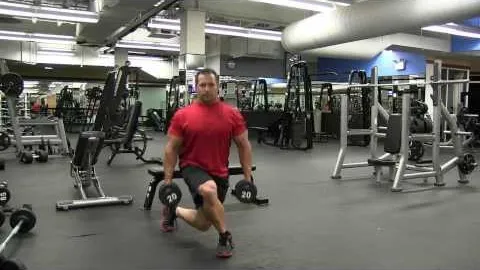
Are you looking for a challenging exercise that can help improve your lower body strength, stability, and balance? Look no further than the dumbbell curtsy lunge. This exercise targets multiple muscle groups, including the glutes, quads, hamstrings, and core, making it an excellent choice for anyone looking to tone their lower body or improve athletic performance. In this article, we will explore the benefits, proper form, and variations of the dumbbell curtsy lunge.
Strengthens the Lower Body: The dumbbell curtsy lunge primarily targets the glutes, quads, and hamstrings. By incorporating this exercise into your workout routine, you can strengthen and tone these muscle groups, leading to improved functional movement and overall lower body strength.
Improves Balance and Stability: The curtsy lunge movement involves a cross-behind step, which challenges your balance and stability. This exercise can help improve your proprioception and coordination, making everyday movements more controlled and efficient.
Targets Multiple Muscle Groups: In addition to the glutes, quads, and hamstrings, the dumbbell curtsy lunge also engages the core, hip abductors, and adductors. This holistic approach to strength training can help you develop a well-rounded physique and reduce the risk of muscle imbalances.
Increases Hip Mobility: The cross-behind step performed in the curtsy lunge can help improve hip mobility by stretching the hip flexors and activating the gluteus medius. Enhanced hip mobility is crucial for proper movement mechanics and can help prevent injuries, especially in activities that involve lateral movements.
To perform the dumbbell curtsy lunge correctly, follow these steps:
Starting Position: Stand tall with your feet hip-width apart, holding a dumbbell in each hand at arm's length by your sides. Engage your core and maintain an upright posture throughout the exercise.
Execution: Take a step backward and diagonally across your body with your right foot, landing on the ball of your foot. Keep your left foot planted firmly on the ground. As you lower your body into a lunge position, ensure that your knees are aligned with your toes and your weight is evenly distributed.
Depth of Lunge: Descend into a lunge position until your front thigh is parallel to the ground, or as close to parallel as your mobility allows. Your back knee should hover slightly above the ground.
Return to Starting Position: Push through your front heel to stand back up, bringing your right foot back to the starting position. Repeat the movement by stepping back and diagonally across your body with your left foot.
Once you have mastered the basic dumbbell curtsy lunge, you can try these variations to keep challenging your muscles and prevent plateau:
Reverse Curtsy Lunge: Rather than stepping back diagonally across your body, step behind yourself in a straight line. This variation shifts the focus to different muscles, particularly the gluteus medius and the lateral hip stabilizers.
Curtsy Lunge with Front Raise: Perform a dumbbell curtsy lunge as described earlier, but when you push back up, lift your arms straight in front of you until they are at shoulder height. This variation adds an upper body workout element, engaging the shoulders and core more intensely.
Elevated Dumbbell Curtsy Lunge: Stand on a step or an elevated surface and perform the dumbbell curtsy lunge. The added elevation will increase the range of motion and engage the muscles in a different way, providing a greater challenge.
To avoid injuries and get the most out of your dumbbell curtsy lunges, follow these safety considerations and tips:
Start with Light Weights: When attempting any new exercise or variation, start with lighter weights to ensure proper form and minimize the risk of injury. As you become more comfortable and confident, gradually increase the weight.
Maintain Good Posture: Keep your back straight and your core engaged throughout the movement. Avoid rounding your back or leaning too far forward. Maintaining good posture will help protect your spine and prevent unnecessary strain on your lower back.
Engage Your Glutes: Focus on squeezing your glutes as you push back up from the lunge position. This will ensure that you are effectively targeting the glute muscles and maximizing the benefits of the exercise.
Breathe Properly: Inhale as you lower yourself into the lunge position and exhale as you push back up to the starting position. Proper breathing will help you maintain control and rhythm throughout the exercise.
Incorporate the dumbbell curtsy lunge into your regular fitness routine to elevate your lower body workout and challenge your muscles in new ways. Remember to always prioritize proper form and listen to your body's limits. With dedication and consistency, you will soon reap the benefits of this effective full-body exercise.
If you're looking for a gym, fitness club or yoga studio, you've come to the right place.
You can find information about gyms in your area. Browse catalog of gyms and find gyms with classes which are you looking for.
On gym page you can find simple information like address, phone or website. You can find list of available classes. You can check availability of personal training or small group classes. On place page you can also see information about open hours.
You can find gyms near you with amenities, courts, studios and equipments.
Use our map to find gym at your city or district.
In Gym Navigator you can find list of exercises with movies for many body parts.
You can browse exercises catalog and find exercises the best of you.
You can also find exercises grouped into workout plans, which you can use to improve you body. Each routine show you exercises one by one and give you possibility to count you progress and count down rest time.